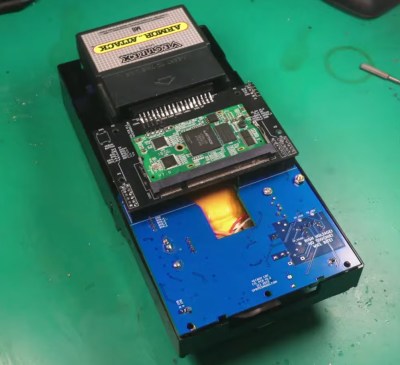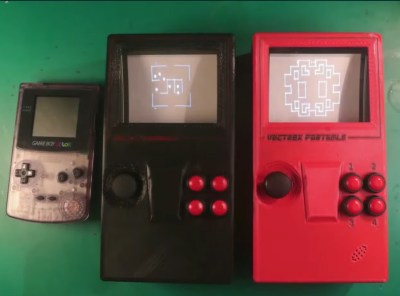The Vectrex was a unique console from the early 1980s. Developed by a company you’ve probably never heard of—Smith Engineering—it was put into production by General Consumer Electronics, and later sold by Milton Bradley. It was an outright commercial failure, but it’s remembered for its sharp vector display and oddball form factor.
The Vectrex was intended for tabletop use in a home environment. However, [Jeroen Domburg], also known as [Sprite_tm], decided to set about building a portable version. This wasn’t easy, but that just makes the development process a more interesting story. Thankfully for us, [Sprite_tm] was kind enough to tell the tale at the 2023 Hackaday Supercon.
Vectorlicious

[Sprite] starts by introducing the audience to the Vectrex, just to make sure everyone understands what was special about this thing. For comaprison’s sake, he lines it up against its contemporaries. Back in the early 1980s, the Atari 2600 and the Intellivision had incredibly low resolution video output with big ugly pixels. In contrast, the Vectrex could draw clean, sharp lines with its inbuilt vector-style display.
Basically, instead of coloring in individual pixels, the Vectrex instead drew lines from point to point on the screen. It was an entirely different way of doing graphics—fast, tidy, and effective—and it was popular in early video arcade games, too. Some Vectrex games even came with plastic overlays to create the impression of color on the screen. Unlike pixel displays, though, this technology didn’t really scale well to prettier, more lifelike graphics. Thus after the Vectrex, no other mainstream consoles adopted this technique.

From there, [Sprite_tm] walks the audience through the hardware of the Vectrex. The architecture is fairly simple, based around a 68A09 CPU, which is a Motorola CPU with some improvements over the earlier 6502. It’s paired with some ROM, RAM, and I/O glue logic, and it loads its games off cartridges. Then there’s the audio hardware, a digital-to-analog converter for video output, and all the subsequent analog electronics for driving the vector CRT display.
Unlike a modern console, what’s inside the box is no secret. Datasheets and full schematics are publicly available that lay out exactly how the whole thing works. This is hugely valuable for anyone looking to repair a Vectrex—or make a portable one. You don’t need to reverse engineer much, since it’s all laid out for you. Indeed, as [Sprite_tm] notes, a replica motherboard already exists that lets you play Vectrex games on an oscilloscope’s XY input.
Building the Portable
Some people have built small Vectrexes before, by going the emulator route with a Raspberry Pi and a small LCD display. [Sprite] wasn’t a fan of this route, as modern pixel LCDs make for jagged diagonal lines because they’re not proper vector displays like the original Vectrex CRT. Thus, to build a more authentic portable Vectrex, [Sprite_tm]’s build needed certain parts. On top of replicating the CPU and logic of the Vectrex, he needed to find a small CRT that operate as a proper vector display. Plus, he wanted to build something properly portable—”I wanna sit on the bus and then whip it out and play it,” he explains.
Obviously, finding a suitable CRT was the first big hurdle to clear. [Sprite_tm] mused over using a tube from a Sony Watchman handheld portable TV, but decided against it. He notes that these are fairly rare and valuable, and he didn’t want to destroy one for his project. But he still needed a small CRT in a practical form factor, and he found the perfect donor. In the 90s, LCDs were pretty crap and expensive, so apartment video intercoms relied on CRTs instead. Now, these systems are all largely defunct, and he notes you can find old examples of these answerphones for a few dollars online.

Of course, these answerphone CRTs weren’t designed for vector operation. However, [Sprite_tm] teaches us how you can convert one to draw straight lines on command instead of scanning like a TV. You can get legit vector operation just by squirting the right voltages into the deflection coils. Of course, getting it to work in practice is a lot harder than you might think, but perseverance got the job done in the end. Understanding the physics involved is useful, too, and [Sprite_tm] explains the theory with an apt comparison between coils and a pig.
From there, the talk explains how the rest of the hardware came together. [Sprite_tm] elected to stuff all the Vectrex magic into an FPGA, which felt cooler than software emulation but was more compact than using all-original chips on a replica mainboard. It lives on a custom PCB that also carries all the necessary electronics to drive the CRT in the desired vector mode.
The build also has a cartridge port for playing original Vectrex games. However, for ease of use, [Sprite] also fitted a RISC V CPU, some RAM, and a microSD card for loading ROMs for games that he doesn’t own in physical format. Everything was then wrapped up in a custom 3D-printed case that’s roughly twice as large as the Nintendo Game Boy Color in length and width—and about four times thicker.


















“an inductor is like a pig”
I hadn’t thought of it that way before.
The Vectrex has some special magic, probably a lot to do with the display. Lots of new information, great article. I think several 6809 powered the Atari Star Wars cabinet, with 3D hardware made in TTL. 6809 was also used most of the 90s in pinball games.
This is a pretty neat build. There may be a doorbell CRT in my stash, as well I have a Vectrex game machine and some carts in my shed. Maybe it would be worth doing a capacitor check then Ebay? I see they are asking quite a bit for them!
ali express has some spare screens like that for around 20$ shipped, no need to try to recover some from old used doorbell…
I have a 19″ Electrahome looking for a home, hard to make it portable though.
This is obviously a pretty rarefied build however you slice it, but even if it was a simple weekend project, the need for scavenged thermionic relics means you’d never see many of these.
I wonder how much mileage there would be in DIY tubes using a laser or a focused LED in place of a cathode ray, and galvos instead of deflection coils. (Or, for raster display, a pair of the spinning mirrors you see in laser printers). Obviously you can’t move mirrors as fast as an electron beam, and I’m sure there are other challenges, but you’d eliminate the need for explodey specialist glass-blowing and high voltages that keeps CRTs outside of the desktop manufacturing realm.
I had an urge to build a laser Spacewars but came to the conclusion that galvos had nowhere near the necessary frequency response. Would love to be proved wrong.
I don’t know why this article is calling these “answerphone” CRTs. “Answerphone” appears to be a generic British term for answering machine, which is all that you’ll find if you search on it. You won’t find any CRTs.
Hey Jeroen, it’d be lovely if you can finish writing up/releasing the design files for this at some point – I’ve had a screen and an FPGA sitting on the shelf waiting for this ever since the talk last year! :D
+1
A kit would be awesome too!
Sprite has always made very creative and inspiring projects. I have several Sony Watchman handheld TV’s, larger portable battery powered CRT TV’s and camera viewfinders (which make fun little displays needing only power and a composite signal). This would be a nice use of them.
Battlezone was a 1980 vector arcade game originally from Atari that was pretty popular. Today you can freely download and play Battlezone on a fairly modern PC in DOSBox, or you can play it online in your browser.[1][2][3][4]
References:
[1] Battlezone (1980 video game):
https://en.wikipedia.org/wiki/Battlezone_(1980_video_game)
[2] DOSBox:
https://www.dosbox.com/
[3] Battlezone DOS – 1983:
https://www.myabandonware.com/game/battlezone-1np
[4] Battlezone online in your browser:
https://www.myabandonware.com/game/battlezone-1np/play-1np
I have wanted to do this for years :o
I have carts that I haven’t been able to play since my screen went out. I remember getting shocked by the screen once as a kid during a fact finding mission. Now that I’m older and educated, I’m afraid to do it again. Why did I ever stop, oh yea, because life was happening around me. You know how difficult it is to find someone of the opposite sex with the same fascination to electronics and good looks as yourself? Certain sacrifices are always made. Caps die and leak, resistors pop…etc. I’m still looking.
I’ve found a typo. “comaprison’s sake” :)
That’s awesome. Sprite_TM impresses again, thanks for sharing. This is why I read Hackaday! Vector graphics on a CRT. Portable. FPGA. Retro. Upcycled hardware. Love it.